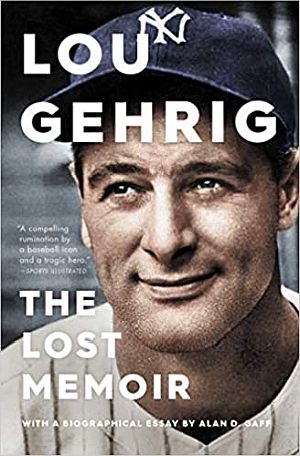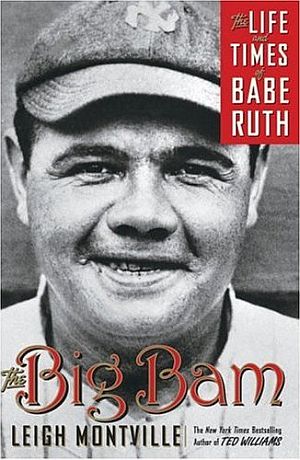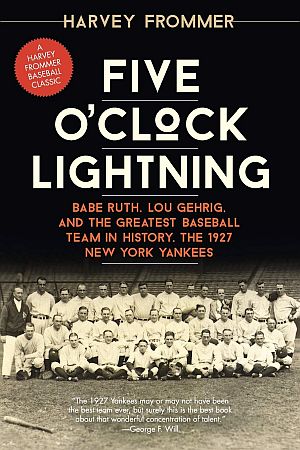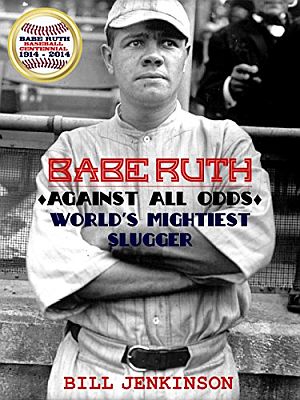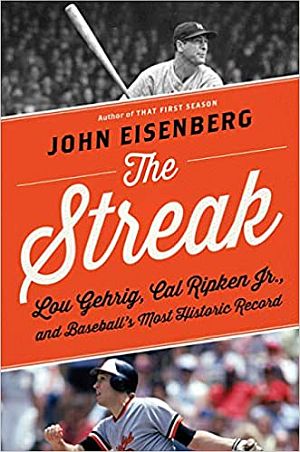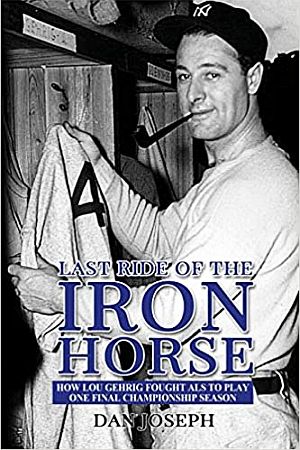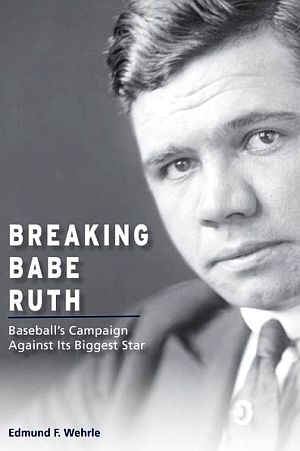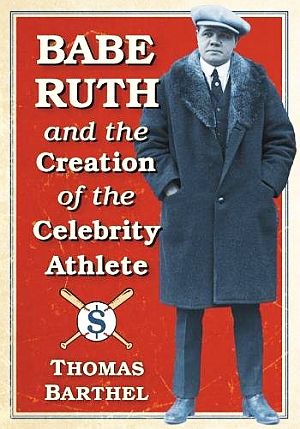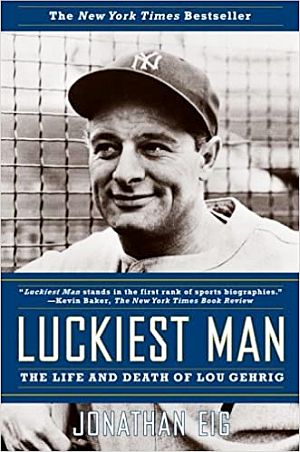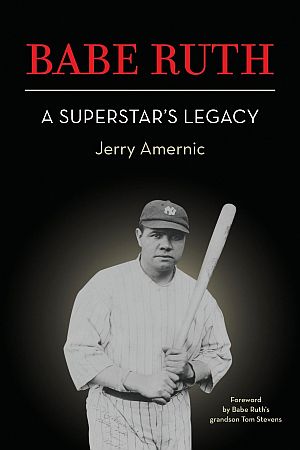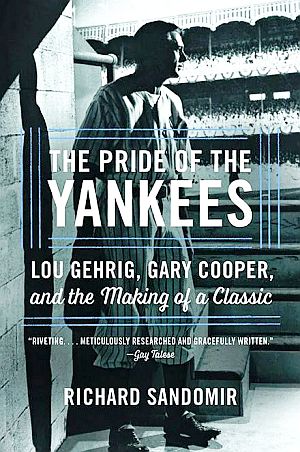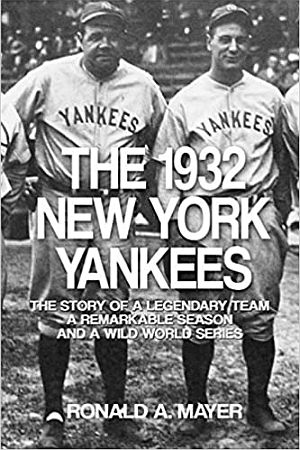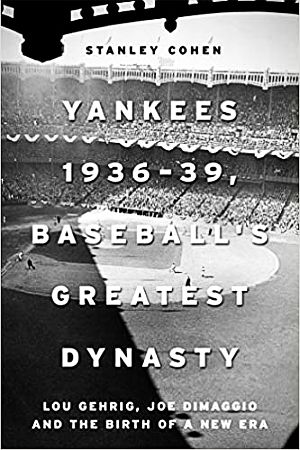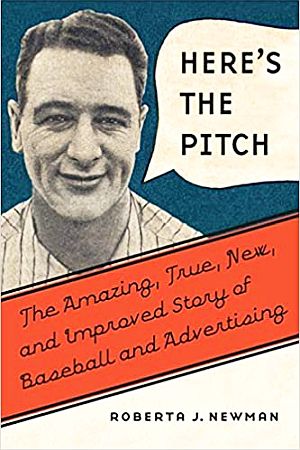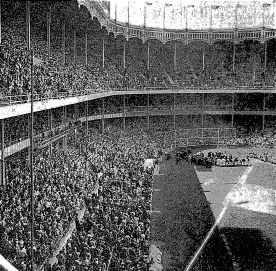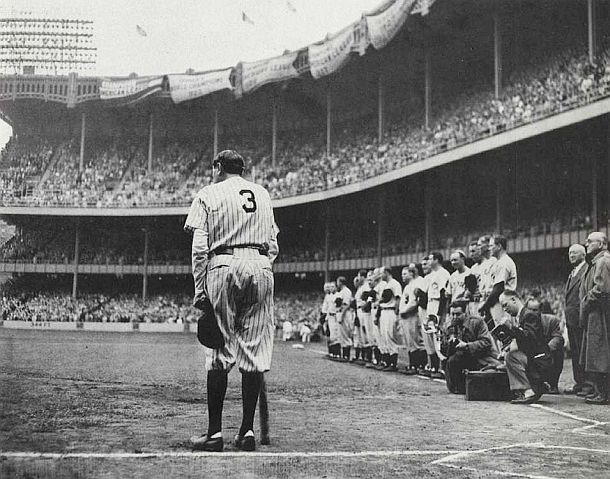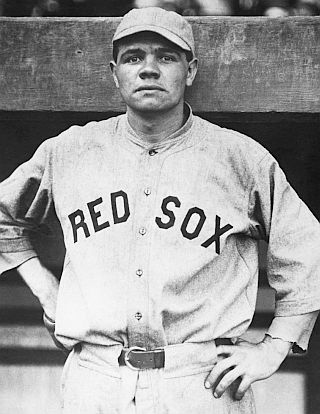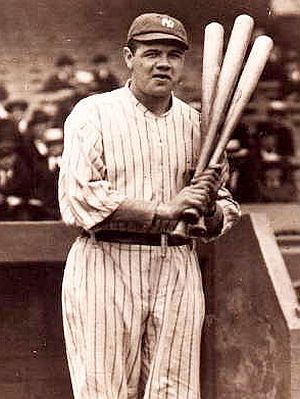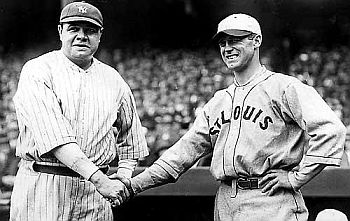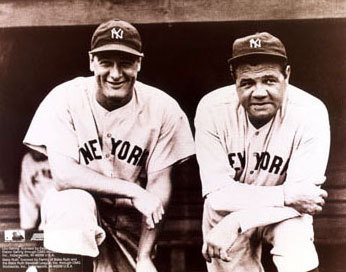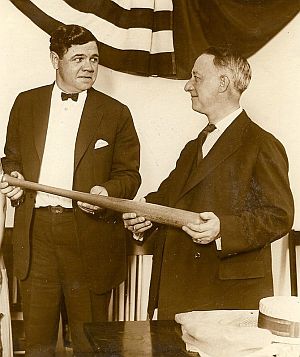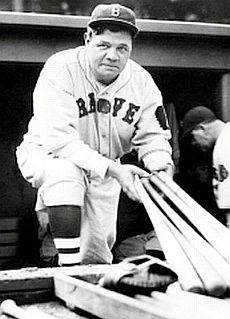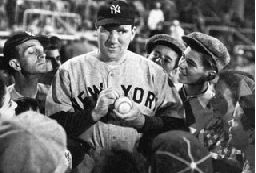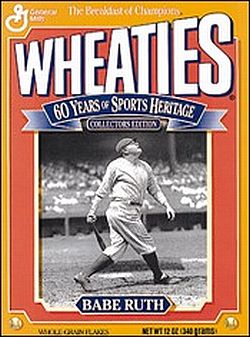In 1927 Babe Ruth and Lou Gehrig were teammates on the New York Yankees professional baseball team. Ruth by then was the larger-than-life “roaring twenties” sports figure and holder of baseball’s home run record, then at 59, which he had set six years earlier in 1921. Ruth had come to the Yankees from the Boston Red Sox in 1919, where he had starred as a pitcher and hitter from 1914 to 1919, setting the home run record for the first time there in 1919 at 29. No professional player before that time had hit more than 16 home runs in one season – a time known as the “dead ball era,” given the quality of the ball used and rarely replaced; a time when play was focused more on singles hitting and base stealing, nicknamed later as “small ball.” But Babe Ruth would change that.

September 15, 1927. Lou Gehrig and Babe Ruth of the New York Yankees, during a season in which the Yankees won the pennant and the World Series, with Ruth setting the home run record at 60 and the pair accounting for more than 100 home runs between them that year, as well as 338 RBIs and 307 runs scored. World Wide Photos.
When Ruth began play with the Yankees in 1920, the team then shared the Polo Grounds stadium with the New York Giants of the National League. On May 1st that year, Ruth hit his first Yankee home run, a ball that left the Polo Grounds. By year’s end, Ruth had hit a prodigious 54 home runs, nearly doubling the existing record – his own, set the year before. No other player was even a close second to Ruth in 1920, with George Sisler of the St. Louis Browns next highest at 19. The following year, Ruth set the record again, hitting 59, with the two next-best hitters far behind at 24. In a few short years, Babe Ruth had changed baseball, bringing more excitement and drama to the game, making it both more popular and more lucrative, as fans flocked to major league ball parks to see Ruth and “home run baseball.” Through the 1920s Babe Ruth was the Home Run King and the biggest celebrity in sport — and quite an incorrigible, fun-loving, and sometimes controversial character to boot. By 1923 he was holding court and hitting home runs in the new Yankee Stadium, later dubbed “The House That Ruth Built.”
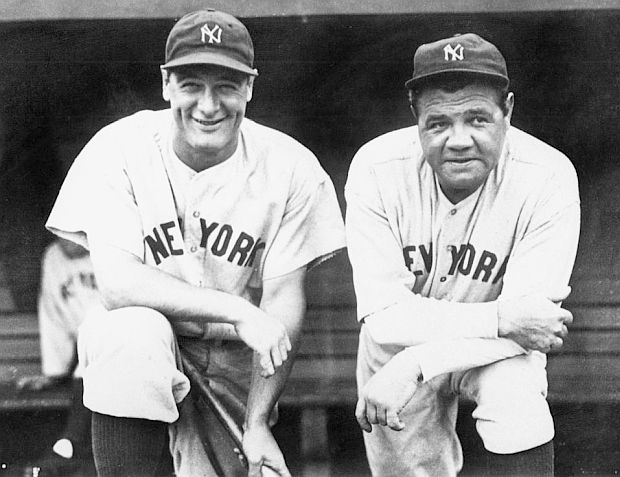
Yankee greats, Lou Gehrig and Babe Ruth, on the steps of their dugout, 1920s.
Lou Gehrig, by comparison, was a Yankee newcomer, and a more reserved character all around, though loaded with baseball talent. Born to German immigrant parents, Gehrig grew up in New York city, where he played high school baseball. At age 17, in a high school game at Wrigley Field in Chicago, he hit a grand slam home run that left the ball park, an unheard-of feat for a high school athlete. He attended Columbia University for two years, played baseball there, continued to hit some notably long home runs, and signed with the New York Yankees in 1923, starting with their minor league club in Hartford, CT. He joined the Yankee team in 1925 and saw limited play. The following year, 1926, was his breakout season with the Yankees, batting .313 with 47 doubles, an American League-leading 20 triples, 16 home runs, and 112 RBIs.
In 1926, Ruth, for the fifth time, had led the majors in home runs with 47. But in 1927, he vowed to set a new home run record with the goal of eclipsing his earlier record of 59 home runs. The 1927 New York Yankees, meanwhile, were one of the best teams in baseball history, not only benefitting from the services of Ruth and Gehrig, but also a lineup of other superb hitters and pitchers. In fact, the first portion of the Yankee lineup that year came to be known and feared by opposing pitchers as “Murderers’ Row” – Earle Combs, Mark Koenig, Babe Ruth, Lou Gehrig, Bob Meusel, and Tony Lazzeri.
But Ruth, for his part, started slow in the 1927 season, hitting only one homer in his first 10 games. By the end of June he picked up the pace, ending the month with 25, only to find the 24-year-old Gehrig right there with him. Through July and August 1927, in fact, Gehrig and Ruth were never separated by more than two home runs. By the end of July, Gehrig was one up on Ruth, 35 to 34. Ruth then took the lead by the end of August, besting Gehrig by a count of 43 to 41. Both men homered on September 2, with Gehrig going deep twice, leaving the standings at Ruth 44, Gehrig 43.
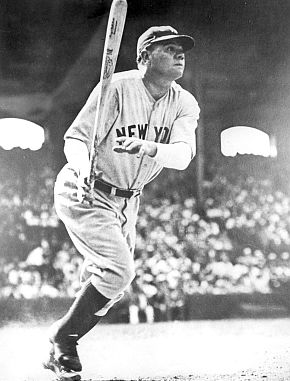 Babe Ruth, completing a swing after contact, 1920s. |
 Lou Gehrig on the move after hitting the ball, 1938. |
In early September, however Gehrig began a bit of a home run drought, not hitting one for a stretch of 19 games. Ruth then moved ahead, hitting 12 more, bring his total to 56. He soon matched his previous record of 59, reaching that mark on September 29, 1927 after hitting two homers against the Washington Senators. At that point, two games remained in the regular season. The very next day, on September 30, 1927, Ruth went deep with a homer, setting a new record at 60. It was the seventh time since 1919 that he had set the single-season home run record. On October 1st, the last day of the 1927 season, he had a chance to hit No. 61, but he went 0-for-3 that day. In any case, most people thought Ruth’s home run mark of 60 would stand for the ages and never be broken. But 34 years later, another New York Yankee, Roger Maris – then also in a home run race with teammate Mickey Mantle – would break Ruth’s record hitting 61 home runs.
What follows below in the left-hand column is a look at some of the newspaper and magazine headlines Ruth and/or Gehrig generated during 1927, a share of which tracks their “home run race” in the context of Yankee games from April-though-September 1927. In the right-hand column is a selection of books on Ruth and Gehrig and the 1927 Yankees, along with a few related films.
__________________________________________
Ruth-Gehrig History
1927 Baseball Season & Beyond
“Mighty Bambino, Full of Vim and Vigor, Arrives in Salt Lake for Week’s Stay; Great Crowd Greets Home-Run King Upon Arrival From Coast,” Salt Lake Tribune (Salt Lake City, UT), January 26, 1927, Sports, p.1.
“Trainer for Ruth Named; Arthur McGovern to Help Condition the Babe on the Coast,” New York Times, January 27, 1927, Sports, p.14.
“Babe Ruth Takes to Road; Runs Five Miles at Hollywood in Preparation for 1927 Campaign,” New York Times, February 5, 1927, Sports, p. 10.
“Ruth, 33, Deposits $33,000, Part of Off-Season Earnings,” New York Times, February 9, 1927, Sports, p. 14.
“Ruth Returns $52,000 Contract, Ready to Quit; Ruppert, Unconcerned, Just Says ‘All Right’,” New York Times, February 10, 1927, Sports, p.18.
“Babe Serious About Quitting; Talks of Opening a String of Gymnasiums,” New York Times, February 11, 1927, Sports, p. 25.
“Ruth Gets $210,000 for 3 Years As Yank,” New York Times, March 3, 1927.
Associated Press, “Ruth’s Annual Income Exceeds All Athlete’s Profits, Except Tunney’s,” Bangor Daily Commercial (Bangor, ME), March 3, 1927, p. 1.
“Tennessee House Adjourns To See Babe Ruth Perform,” New York Times, April 8, 1927, Sports, p. 27.
Richards Vidmer, “Yanks Beat Cards by Rally in Tenth; Bunch Three Singles, One by Ruth, Then Win on Gehrig’s Sacrifice, 5 to 4,” New York Times, April 7, 1927, Sports, p. 17.
“$1,000 for Homer Today; If Ruth Hits Circuit Clout Ball Will Be Sold for Charity,” New York Times, April 12, 1927, Sports, p. 30.
James R. Harrison, “Ruth’s Homer Aids in Yankee Victory; His First of Season Opens Attack That Beats Athletics, 6-3… Babe’s Toss Stops Run at the Plate,” New York Times, April 16, 1927, Sports, p.18.
James R. Harrison, “Lazzeri and Gehrig Pummel Athletics; Each Hits Homer with Two on in Accounting for Net Total of Ten Runs; Yankees Triumph, 13 to 6…,” New York Times, April 22, 1927, Sports, P. 14.
Ford C. Frick, “Babe Ruth Checks up on Low Batting Average,” New York Evening Journal, April 23, 1927.
James R. Harrison, “Ruth Hits Homer as Yanks Win, 6-2; His Third Circuit Blow and Second in Two Days Travels 400 Feet Before Disappearing. Durst Routs Senators Triples with Bases Filled Following Babe’s Drive in Sixth — Meusel Also Gets Four-Bagger,” New York Times, April 25, 1927, Sports, p. 28.
Arthur Mann, “Lou Gehrig MVP So Far,” The Evening World (New York), April 29, 1927.
Richards Vidmer, “3 Yank Homers Win as 70,000 Look On; Ruth Gets Two, Pushing Total to Six…,” New York Times, May 2, 1927, Sports, p. 16.
“Younger Set Aids Yanks to Victory; Youthful Zest of Lou Gehrig and Deacon Moore Helps Beat Senators, 6 to 4,” New York Times, May 4, 1927, Sports, p. 21.
“Pennock and Gehrig Raid White Sox, 8-0; Herb Finishes Well, the Five Hits off Him Coming in as Many Innings. Lou’s Homer Clears Bases Delivered in Ninth, it More than Clinches Yanks’ Opener in Western Invasion,” New York Times, May 8, 1927, Sport, P. 1.
“Lou Gehrig’s Drive Yanks’ Life-Saver; His Single in Ninth with Paths Loaded Brings Downfall of Browns, 8-7. Ruth Gets Homer No. 7 Babe’s Only Hit Comes with Two On …,” New York Times, May 11, 1927, Sports, p. 20.
James R. Harrison, “Yankee Siege Guns Subdue Tigers, 6-2; Homer by Gehrig and Timely Single by Ruth Help Win Icy Game,” New York Times, May 17, 1927, Sports, p. 33.
Harold Heffernan, “‘Babe Comes Home’ Babe Ruth, Good Ball Player,” The Detroit News, May 16, 1927 [Ruth in film].
Charles M. Segar, “Errors Costly; Boots by Babe, Koenig Give Senators 3-2 Win,” Daily Mirror (New York), May 24, 1927.
James R. Harrison, “Ruth Hits a Homer but Yanks Lose, 3-2; His Eleventh of Season and Gehrig’s Tenth Wasted as Senators Win,” New York Times, May 24, 1927, Sports, p. 28.
James R. Harrison, “Ruth’s Fourteenth Helps Yanks Divide; Propelled in Eleventh Frame, it Beats Athletics, 6-5…,” New York Times, May 31, 1927, Sports, p. 27.
Charles M. Segar, “Babe’s 14th Homer Earns Yanks Split With A’s; Wins Evening Battle in Eleventh,” Daily Mirror, May 31, 1927.
Monitor, “Ruth’s 17th Homer Wins It In Rain-Soaked Game,” The World (New York), June 6, 1927.
James R. Harrison, “Ruth’s Two Blows Upset Tigers, 5-3; His 17th Homer Gives Yanks Temporary Lead, While His Hit in Eighth Wins Game,” New York Times, June 6, 1927, Sports, p.17.
W.O. McGeehan, “Babe Ruth’s Drawing Power,“ Herald Tribune (New York), June 6, 1927.
James R. Harrison, “Yanks Rise in 7th and Beat White Sox;… Babe Ruth Steals Home; He Also Triples…,” New York Times, June 10, 1927.
“Ruth’s Pen Kept Busy.; Autographs 53 Baseballs for Citizen Training Camps,” New York Times, June 10, 1927, Sports, p. 26.
James R. Harrison, “Babe Hits 2 More as Yanks Win, 6-4; Lifts His Second Longest Homer into Centre Field Bleachers as 30,000 Gasp. Then Drives out No. 20 Dismays Visiting Indians by Getting Two in Row off Garland Buckeye. Luke Sewell Suspicious Inspects Ruth’s Bat after No. 19…,” New York Times, June 12, 1927, Sports, P. 1
Ford C. Frick, “Lindbergh’s Arrival Upstages Game,” New York Evening Journal, June 17, 1927.
James R. Harrison, “Lindbergh Misses Ruth’s 22d Homer; Reaches Stadium After Game Is Over and Yanks Have Beaten Browns, 8-1. Gehrig Helps Hoyt Win Also Gets 4-Bagger in First Frame — Game’s Start Delayed 25 Minutes to Await Air Hero,” New York Times, June 17, 1927, Sports, p. 17.
James R. Harrison, “Yanks Score Twice; Ruth Hits 2 Homers; Circuit Drives in the Fifth and Seventh Upset First Game, 7 to 4, for Red Sox.., Have Won Eight in Row, New York Times, June 23, 1927, Sports, p. 19.
Associated Press, “Gehrig’s Three Homeruns Puts Him Back in Race For Crown; Yanks Hit Hard Pace For League,” The Fargo Forum (Fargo, ND), June 24??, 1927, p. 15.
“Supreme Court Decides Against Sunday Baseball,” The Evening Bulletin (Philadelphia, PA), June 25, 1927.
“Baseball By Electric Lights Proves Success,” The World (New York), June 25, 1927.
“Ruth Wants Tax Cut for Playing Host; Files Appeal Stating He Spent $9,000 Entertaining Writers During 1924,” New York Times, June 26, 1927, Sports, p. 2.
Arthur Mann, “Lou Gehrig, Kid From the Bronx, Presses Ruth for Home Run Honors,” The Evening World (New York), June 28, 1927.
James R. Harrison, “Gehrig Hits Homer, Ties Ruth With 24; His Safety in Fifth Is One of 15 That Yanks Get to Beat Red Sex, 8-2. Babe Back, Gets 4 Hits Makes 3 Singles and Double, Starts 2 Rallies, Drives in a Run Despite Sore Knee…,” New York Times, June 30, 1927, Sports, p. 19.
Associated Press, “Ruth’s Homer Reign Is Menaced by Gehrig,” Baltimore News, July 1, 1927, Sports, p. 1.
James R. Harrison, “Gehrig Gets No. 25, Then Ruth Ties Him; Lou’s Homer Comes in First, Babe’s in Fourth and They Help Beat Red Sox, 13-6….,” New York Times, July 1, 1927, Sports, p. 17.
Ford C. Frick, “Big Stick Is Only Link Between Home-Run Stars” [i.e., Ruth and Gehrig], New York Evening World, July 2, 1927.
Daniel, “Odds Favor Gehrig to Beat Out Ruth in Home Run Derby,” New York World Telegram, July 5, 1927.
David J. Walsh, “Lou Gehrig Jumps Field in Race for Home Run Crown,” Baltimore News, July 6, 1927, Sports, p. 1.
“Gehrig, Rival of Babe Ruth, His Powerful Shoulders and How He Grips His Bat”[w/4 Photos], Baltimore News, July 6, 1927, Sports, p. 1.
Richards Vidmer, “Yanks Break Even as Ruth Hits No. 27…; Lose First Game of Western Tour to Tigers, 11-8, Then Win Final of Twin Bill, 10-8. Babe’s’ Drive a Big Aid Comes in Closing Battle with Two on Base…,” New York Times, July 9, 1927, Sports, p. 8.
Richards Vidmer, “2 Homers for Ruth; Yanks Divide Day; Babe Regains Home Run Lead with 28th and 29th as Tigers Lose, 19-7, Then Win, 14-4…,” New York Times, July 10, 1927, Sports, p. 1.
Richards Vidmer, “Buster [Gehrig nickname] Ties Babe in Home-Run Dash; Gehrig Bats Out 29th Circuit Blow While Yankees Tame Tigers at Detroit, 8-5….,” New York Times, July 12, 1927, Sports, p. 19.
Richards Vidmer, “Babe Lifts No. 30 as Yanks Win, 7-0; Breaks Tie with Gehrig in Home-Run Race at the Indians’ Park. Clout Comes in the Ninth Bambino Awakes after 14 Hitless Trips…,” New York Times, July 13, 1927, Sports, p. 17.
Richards Vidmer, “Yank Rally Beats the Indians, 5 to 3; … Ruth Has a Perfect Day Gets 3 Singles and a Double in Four Tries…,” New York Times, July 14, 1927, Sports, p. 16.
Richards Vidmer, “Gehrig’s Three Hits Win for Yanks,5-2; Scores One Run and Bats in Three Others as Browns Are Downed in Opener. Clinches Victory in 7th; Buster Cracks Double with Bases Filled, Two Men Scoring…,” New York Times, July 17, 1927, Sports, p. 1.
Richards Vidmer, “Gehrig Hits No. 30, Tying Ruth Again; Homer in Eighth Evens Game at Four-all, While Meusel’s Blow Beats Browns, 5-4…,” New York Times, July 18, 1927, Sports, p. 10.
Ford C. Frick, “Lou Regains Batting Form on Diet of Pickled Eels,” New York Evening Journal, July 19, 1927.
Richards Vidmer, “Gehrig Clouts One as Yanks Prevail; Lou Leaves Babe Behind When He Hits Homer No. 31 in Clash with Browns. Hugmen Win by 10 to 6 Beat St. Louis Tenth Time in Row — Sisler Gets Circuit Blow with Bases Full,” New York Times, July 19, 1927, Sports, p. 18.
Richards Vidmer, “Fans Worship Ruth but Forget Gehrig; Though Babe Trails Lou in Home Runs, He Leads Him in Popular Appeal to Crowds…,” New York Times, July 21, 1927, Sports, p. 16.
W. B. Hanna, “Theories of Ruth, Gehrig, Huggins Why More Home Runs Are Being Hit Than Ever Before; Babe Says it’s Because Players Have New Style; Declares ‘Swingin` From Hips’ Produces Results; Gehrig Says Pitching,” New York Herald Tribune, July 24, 1927.
Richards Vidmer, “Ruth Clouts No. 31 to Help Yanks Win; Babe Again Draws Even with Gehrig in Homer Race as Chicago Is Beaten, 3-2,” New York Times, July 25, 1927, Sports, p. 13.
Monitor, “Ruth Ties Gehrig as Yankees Beat White Sox, 3-to-2; Record Crowd Sees Babe Hit Longest In and Out of Park,” The World (New York), July 25, 1927.
Richards Vidmer, “Ruth Hits 2, Gehrig 1 as Yanks Win Two; Hugmen’s Cyclonic Slugging Floors Browns Twice, 15-1 and 12-3. Babe Sets Homer Pace, Boosts Total to 33, Against 32 for Buster, All Three Soaring into Bleachers. Ruth Collects 7 Blows…,” New York Times, July 27, 1927, Sports, p. 18.
Richards Vidmer, “Gehrig and Lazzeri Win for Yankees; Lou Hits His 33d Homer and Ties Ruth…,” New York Times, July 28, 1927, Sports, p. 12.
Joe Williams, “A Close-up of Christy Walsh. The Man Behind Mr. Babe Ruth. About These Literary Athletes,” New York World Telegram, July 29, 1927.
Richards Vidmer, “Ruth Hits His 34th as Yanks Triumph; Babe Passes Gehrig When the Browns Lose 15th Straight to Hugmen — Score, 9-4….,” New York Times, July 29, 1927, Sports, p. 11.
Richards Vidmer, “Gehrig’s 2 Homers Pass Babe for Lead; He Ties Ruth with His 34th at Stadium, Goes Ahead When 35th Hops into Stands…,” New York Times, July 31, 1927, Sports, p. 1.
“Babe’s $50,000 Trust Fund,” New York American, August 9, 1927.
“Cub Fans Scout Yankees as They Trim Sox, 8 to 1,” Chicago Daily Tribune, August 17, 1927 (game at Comiskey Park with photo of Ruth crossing home plate after home run; reportedly, first time any player had ever hit a ball out of Comiskey Park).
Richards Vidmer, “Ruth’s 38th Trims White Sox in 11th…Hit Ties Him with Gehrig …Yanks Get One in Fifth and Eighth, Then Win by 3-2,” New York Times, August 18, 1927, Sports, p. 15.
Richards Vidmer, “Gehrig Slams 39th but Yanks Trail, 3-2; Lou Passes Ruth in Home-run Race, Drives in Other Tally, but White Sox Win,” New York Times, August 20, 1927, Sports, p. 11.
Richards Vidmer, “Ruth Crashes 39th as Yanks Fail Again; Babe Evens Homer Count with Gehrig While Indians Trounce Hugmen by 14 to 8… Tribe Amasses 19 Hits …Grant Stills Mighty Yankee Bats…,” New York Times, August 21, 1927, Sports, p. 1.
Sam Greene, “Hit Costs The Babe $300 And Tiger’s A Ball Game…,” The Detroit News, August 27, 1927.
Richards Vidmer, “Ruth Crashes 41st as Yanks Win, 14-4; Babe Also Get a Triple While Browns Lose 16th in Row to the Hugmen,” New York Times, August 28, 1927, Sports, p. 1.
Richards Vidmer, “Gehrig, Hits No. 41 as Yanks Win, 8-3; Drive with Two on Helps Down the Browns for the 18th Straight Time. Ruth Stars in Field Makes Six Brilliant Catches in Left Field — Babe Leads Lou by Only One Homer,” New York Times, August 30, 1927, Sports, p. 16.
Cover Story, Lou Gehrig on cover, “Lou Gehrig, Babe Ruth’s Most Sensational Rival,” Baseball Magazine, September 1927.
Paul Gallico, “A Great Moral Lesson” (Ruth-Gehrig race), Daily News (New York), September 3, 1927.
“Yesterday’s Crowd At Fenway Park Another Tribute to Babe Ruth; New England Fans Jam Ball Field To Capacity With Many Turned Down,” Boston Evening Transcript, September 6, 1927.
John Drebinger, “Yanks Bow in 18th, but Split 2 Games; Lose to Red Sox, 12-11, Before 36,000… Gehrig’s 44th Ties Ruth Gets Blow in 1st Game…,” New York Times, September 6, 1927, Sports, p. 28.
John Drebinger, “Yanks Break Even; Ruth Hits 3, Gehrig 1; Hugmen Rout Red Sox, 14 to 2; Then Boston Takes Second Contest, 5 to 2. Babe Equals 1926 Mark His 45th, 46th and 47th Overshadow Buster’s [Gehrig nickname] 45th, Which Put Lou Ahead for Inning. Ruth 7 Behind Record Had 54 at this Stage of Season in 1921…,” New York Times, September 7, 1927.
James R. Harrison, “Does Paul Waner Top Gehrig in Value to His Team? A Fan Asks; Expert Contends That Pittsburgh Star, Who Is Backbone of Team, Has the Edge, as Gehrig Is Only One among a Galaxy of Dangerous Hitters,” New York Times, September 8, 1927, Sports, p. 30.
John Drebinger, “Ruth Hits 48th, 49th as Yanks Sweep On; Babe Increases Margin over Gehrig to Four Homers as Hugmen Win, 12-10,” New York Times, September 8, 1927, Sports, p. 30.
Burt Whitman, “Ruth Hits Two More Homers; Yanks Beat Red Sox, 12-10; Has 49, With 21 games Left in Which to Equal Record of 59,” The Boston Herald, September 8, 1927.
John Drebinger, “Jinx Gets Lazzeri but Yankees Win… Ruth Saves the Game His Fine Sprint and Daring Slide Home after Lazzeri’s Sacrifice Decide… the Browns Again Victims…,” New York Times, September 9, 1927, Sports, p. 20.
“Ruth, in Court, Denies Attack on Artist, 49; Offers Alibi for Night of July 4th, But Decorator is Sure it Was Home Run King…,” New York Herald Tribune, September 13, 1927.
“Babe Ruth Insured for Only $300,000; ‘Talk of $5,000,000 Is Bunk,’ Says Yankees’ Secretary, ‘No Player Worth It’,” New York Times, September 14, 1927, p. 9.
“Ruth is Cleared of Beating Man in Insult Case; Baseball Star’s Alibi Holds Against Artists’ Assault Charge; Leaves The Court on Shoulders of Admirers…,” New York Herald Tribune, September 17, 1927.
“Yanks Annex 100th as Ruth Hits No. 53; Hugmen Trim White Sox, 7 to 2… Babe Three From Record; Had 56 at This Stage of Season in 1921…,” New York Times, September 17, 1927, Sports, p. 9.
W.B. Hanna, “Ruth Hits 55th But Yankees Lose to Tigers… Babe Also Gets Two Singles Off Gibson,” New York Herald Tribune, September 22, 1927.
William J. Slocum, “Yankees Tie Record With 105th Victory; Bambino’s Clout in Final Frame Overcomes Detroit’s Lead…,” New York American, September 23, 1927.
“Ruth’s 56th Homer Wins Game in Ninth; Scores Koenig, Overcomes One-Run Lead and Downs the Tigers by 8 to 7… Gehrig Clips a Mark,” New York Times, September 23, 1927.
“Ruth to Make Tour with Gehrig to Coast; Pair Will Start [Exhibition] Series of Fifteen Games as Soon as World’s Series Is Over,” New York Times, September 27, 1927, Sports, p. 20.
John Drebinger, “Ruth Hits His 57th with Bases Filled; His Smash off Grove in Sixth Proves Winning Margin in Victory over Athletics by 7-4. Still Behind the Record; Three down and Three Games to Play in Drive for Record Sixty — Gehrig Gets 46th,” New York Times, September 28, 1927, Sports, p. 19.
Thomas Holmes, “Ruth On The Verge of a New Record and His Eighth World Series,” The Brooklyn Daily Eagle, September 30, 1927.
“Babe Ruth Clouts Two Homers, Tying His Own Record at 59…. Yankees’ Slugger Has 2 More Tilts To Set New Mark; Babe’s Circuit Clouts Aid in New York’s 15-4 Win Over Washington; Second Blow Comes With 3 Men on Base in The 5th,” Public Ledger (Philadelphia, PA), September 30, 1927.
John Drebinger, “Ruth Hits 2, Equals 1921 Homer Record; Slams 58th in First Frame, Then Gets 59th in Fifth With 3 Men on Bases [i.e. grand slam]; Barley Misses Two More; Each a Trifle Short and One Goes For Triple as Fans Shriek With Joy… Win by 15-4 as Babe and His Mates Run Wild and Make 19 Safeties,” New York Times, September 30, 1927.
“Ruth Equals Record; Wham! Wham! The Bam’s A Wow; Babe Spanks Two to Knot Mark of 59,” Los Angles Examiner, September 30, 1927.
“Babe Ruth Hits 60th Home Run; Swat King Sets New World’s Record,” Los Angeles Evening Herald, September 30, 1927, front page.
Cover of Sport magazine, September 1927. Artist’s rendition of Babe Ruth swinging a bat appears on the cover with story inside the magazine titled: “Babe Ruth’s Dramatic History Costs Yanks $132.000.” This edition also includes a photo of Lou Gehrig.
“Home Run Record Falls as Ruth Hits 60th…; 1921 Mark of 59 Beaten; Fans Go Wild as Ruth Pounds Ball into Stands With One On…,” New York Times, October 1, 1927, p. 12.
Fred Lieb, “ Babe Ruth Thrills Nation’s Sports Lovers With His Sixtieth Home Run of Season… Eighth Inning Crash Breaks Deadlock, Giving Yanks 109th Victory; Mighty Slugger Scored Sixteen Homers in Sept.,” New York Evening Post, October 1, 1927.
Paul Gallico, “Babe Carpenters No. 60! Ruth Cracks 1921 Circuit Mark As Senators Are Beaten, 4 to 2. And He Did It!,” Daily News (New York), October 1, 1927.
Associated Press, “Ruth’s Homers Have Totaled 50 Miles; Has Poled 416 Out of Park,” Baltimore News, October 1, 1927, Sports, p. 1.
“Babe Ruth’s Home Run Secrets Solved by Science,” Popular Science Monthly, October 1921.
John Drebinger, “Ruth Is Homerless, but Yanks Win Last; 20,000 Fail to See Babe Do it Again as Senators Lose, 4 to 3. Gehrig Comes Through, Gets No. 47… Southpaws Baffle Ruth; He Strikes Out as Last Act of Regular Season…Yankees Win Pennant,” New York Times, October 2, 1927, Sports, p. 8.
“Out to Get Babe and Lou; Pirate Strategy [in World Series] Will Be to Stop These Two to Whip Yanks,” New York Times, October 4, 1927, Sports, p. 24.
“N.Y. Wins World Series By Beating Pirates 4-3; Wild Pitch in 9thg Inning Gives Yanks 4th Straight Game, Los Angeles Evening Herald, October 8, 1927, p. 1.
“Yanks Win; Take Championship; Babe Ruth Drives Out Home Run In Fifth, Scoring Combs Ahead Of Him; Yankees’ Slugger Comes Through With Second Circuit Clout of the Series,” Scranton Times (Scranton, PA), October 8, 1927, p. 1.
John Drebinger, “Yankees Disperse; Four to Barnstorm; Ruth, Gehrig, Lazzeri and Dugan Will Appear in Post-season Games. Each Yank to Get $5,702…,” New York Times, October 10, 1927, Sports, p. 18.
Associated Press, “Best-Player Award Goes to Lou Gehrig; Yankee First Baseman Is Voted Most Valuable Performer in American League… For 1927,” New York Times, October 12, 1927, Sports, p. 32.
“Ruth, Gehrig Back; Played in 9 States; Barnstorming Records Fall as Yankee Stars Play Before 220,000 Persons. Babe Crashed 20 Homers Lou Slammed 13, 21 Games Being Started and 13 Finished — 30,000 Gathering in Los Angeles,” New York Times, November 9, 1927, Sports, p. 30.
Associated Press, “Babe Ruth, Weight 222 1/2, Begins Training For New Record Drive; ‘Might Do It,’ He Says,” New York Times, December 28, 1927, Sports, p. 19.
Ruth-Gehrig Careers
Babe Ruth and Lou Gehrig were the talk of baseball all through the 1927 season, each turning in stellar performances beyond their home runs. Ruth, in addition to his record-setting 60 home runs, finished with a .356 batting average and 164 RBIs, while Gehrig complied a .373 average with 47 home runs and a league-leading 175 RBIs.
Some of Ruth’s home run blasts during 1927 were notable for their distance. One at Griffith Park in Washington, D.C. on July 3rd, 1927, soared deep into the centerfield stands and would be the longest ever hit there until surpassed by a Mickey Mantle homer in April 1953. Another Ruth homer on August 16, 1927 – a towering drive to right field at Chicago’s Comiskey Park – was described by New York Times Richards Vidmer as follows: “Upward and onward it soared in the general direction of the stockyards… And the last seen of it, it was sailing serenely over the roof of the double-decked stands with never a hint of slowing up.” During Ruth’s career there would be other famous home-run moments, such as the much-disputed “called shot” homer against the Chicago Cubs during the 1932 World Series. Sportswriter Red Smith would observe of Ruth: “It wasn’t that he hit more home runs than anybody else, he hit them better, higher, farther, with more theatrical timing and a more flamboyant flourish.”
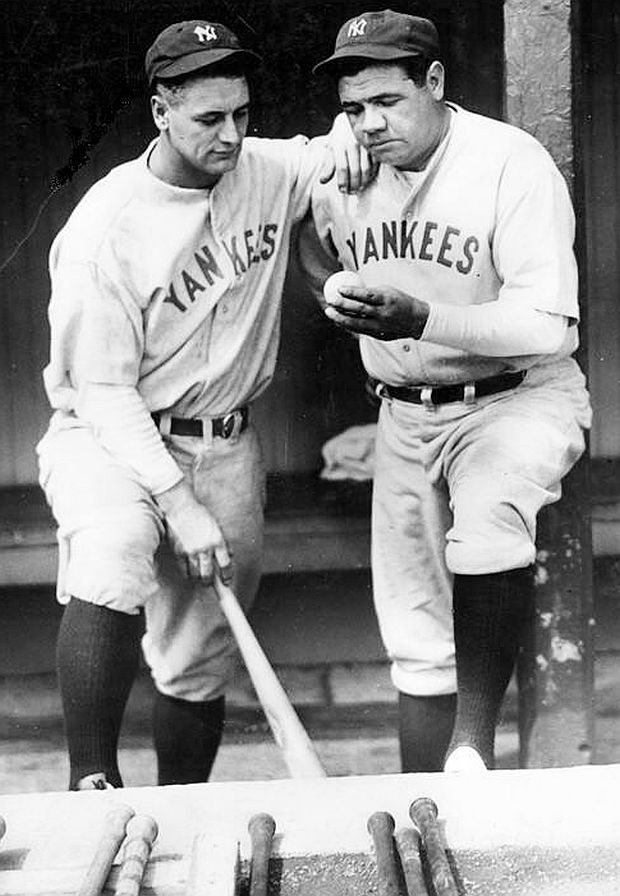
August 11, 1929. Babe Ruth and Lou Gehrig inspecting retrieved home run ball hit by Ruth that day over the right field fence at Cleveland’s League Park (formerly Dunn Field). It was Ruth’s 500th career home run making him the first ever to reach that mark.
But for Ruth, outside of his record 60 home runs in 1927, that year wasn’t his best statistically. In fact, earlier in his career, in 1921, Ruth put up some very formidable numbers. That year he hit 59 homers, batted .378, and led the league in several other categories, including: runs scored (177), RBIs (171) and walks (144). His slugging percentage that year was .846, just a hair off the .847 posted the prior year, a record that stood until 2001. However, he still holds the career slugging record at .690. Yet it would be his home run performance in 1927 that would become his enduring legacy, as well as his 714 career home run total – until those records were broken decades later, respectively, by Roger Maris in 1961 and Hank Aaron in 1974.
Throughout the 1920s, however, it’s fair to say that Babe Ruth owned the home run category. From 1920-1932, he averaged more than 46 home runs a season. His lifetime statistics also include 2,873 hits, 506 doubles, 2,174 runs, 2,214 RBI, a .342 batting average, a .474 on-base percentage and a .690 slugging percentage. Ruth led the American League in home runs 12 times, in slugging percentage 13 times, base on balls 11 times, on-base percentage 10 times, runs scored eight times, and RBIs five times. Ruth retired in 1935 after a partial season with the Boston Braves, ending his 22-year big league career, disappointed that he never got the call to manage a major league team. Ruth passed away on August 16, 1948 after a battle with cancer. He was 53.

June 15, 1932 Chicago Tribune photo taken at Comiskey Park prior to Yankees’ first at-bat against the White Sox that day, with Ruth and Gehrig both holding bats at Yankees’ dugout. Gehrig and Ruth both had good years in 1932: Ruth hit .341 with 41 homers and 137 RBIs; Gehrig hit .349 with 34 homers and 151 RBIs.
Though Lou Gehrig had begun his prolific career in the shadow of Babe Ruth, by the early 1930s, as Ruth’s career wound down, Gehrig would become the dominant Yankee player, setting his own distinguished records. Gehrig, in fact, had a remarkable career. In 13 consecutive seasons he scored more than 100 runs and tallied at least 100 RBIs in every one of those years. He led the American League in runs scored four times, home runs three times, RBIs five times, and on-base percentage five times. He finished among the league’s top three hitters in batting average seven times, compiling eight seasons of 200 or more hits, and winning the MVP award in 1927 and 1936. He set the American League single-season RBI record in 1931 with 185.
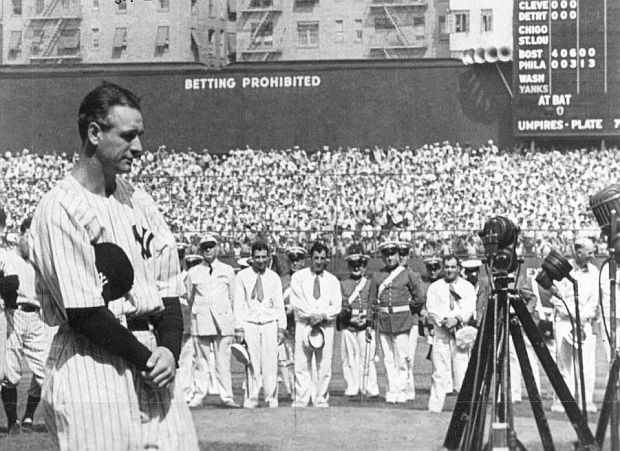
July 4, 1939. Lou Gehrig during farewell ceremony honoring him at Yankee Stadium on his departure from baseball due to the neuromuscular disease, ALS (later named Lou Gehrig’s disease). In his speech, Gehrig noted to fans that they may have read about his bad break, then adding: “...Today I consider myself the luckiest man on the face of the earth. I might have been given a bad break, but I’ve got an awful lot to live for. Thank you”. Gehrig died from ALS in June 1941.
On June 3, 1932, Gehrig hit four home runs in succession during a game against the Philadelphia Athletics at Shibe Park (and nearly a fifth caught at the wall), a one-game feat not then seen in the post-1900 baseball era. In 1934 he took the Triple Crown batting title with a .363 average, 49 home runs, and 166 RBIs. Called the “iron horse” for his durable and consistent play, he set the “consecutive-games-played” record in 1939 after appearing in 2,130 games with the Yankees, a record that stood for 56 years. Were it not for the disease that took him out of baseball at age 36 in April 1939 – the neuromuscular disease, amyotrophic lateral sclerosis, or ALS, later named “Lou Gehrig’s Disease” – he would undoubtedly have set a few more records. At his death in June 1941, he was just short of his 38th birthday.
For additional stories on baseball history and profiles of players such as: Hank Aaron, Sandy Koufax, Mickey Mantle, Jackie Robinson, and others, see the “Baseball Stories” topics page.
Thanks for visiting – and if you like what you find here, please make a donation to help support the research, writing and continued publication of this website. Thank you. – Jack Doyle
|
Please Support Thank You |
____________________________________
Date Posted: 4 June 2021
Last Update: 4 June 2021
Comments to: jdoyle@pophistorydig.com
Article Citation:
Jack Doyle, “Gehrig vs. Ruth, 1927: Home Run Race,”
PopHistoryDig.com, June 4, 2021.
____________________________________
Sources, Links & Additional Information
“Lou Gehrig,” Wikepedia.org.
“Babe Ruth,” Wikipedia.org.
Babe Ruth with Bob Considine, The Babe Ruth Story, 1948, E P Dutton. Click for copy.
Geoffrey C. Ward and Ken Burns, Baseball: An Illustrated History, New York: Alfred A. Knopf, 2010, (updated edition, including 10th inning), 564 pp. Click for copy.
“Babe Ruth,” Baseball Hall of Fame / Baseball Hall.org.
“Lou Gehrig,” Baseball Hall of Fame / Baseball Hall.org.
“1927 New York Yankees Season,” Wikipedia .org.
Eleanor Gehrig and Joseph Durso, My Luke and I. Mrs Lou Gehrig’s Joyous and Tragic Love for the ‘Iron Man of Baseball’, 1976, New York: Thomas Y. Crowell, 229 pp. Click for copy.
Ray Robinson, “Ruth and Gehrig: Friction Between Gods,” New York Times, June 2, 1991, Sports, p. 7.
Ray Robinson, Iron Horse: Lou Gehrig in His Time, 1990, W. W. Norton, 300 pp. Click for copy.
Marshall Smelser, The Life That Ruth Built: A Biography (paperback edition), 1993, Bison Books, 592 pp. Click for copy.
William Nack, “The Colossus,” Sports Illustrated / SI.com, August 24, 1998.
“1927 Newspapers,” 1927: The Diary of Myles Thomas, ESPN.com.
1927: The Diary of Myles Thomas. In 2016, ESPN announced this project as part a new genre of storytelling known as “real-time historical fiction.” The project includes a historical novel in the form of a ballplayer’s diary, complemented by fact-based content from the 1927 season. Through diary entries and additional material, a “re-living” of the famous Yankees season takes place, along with the broader context of that era, exploring the nexus of baseball, jazz and Prohibition.
Steven Goldman, “75 Years Later, Babe Ruth’s Hug Means Almost as Much as Lou Gehrig’s Speech Comments,” SBNation.com, July 8, 2014.
Wayne Coffey, “Luckiest Man of All; 75 Years Ago, Lou Gehrig Gave Us a Glimpse of Courage in the Face of Death,” Daily News (NY), June 29, 2014.
Glenn Frankel, Book Review, “The Truth Behind the Legend of Lou Gehrig,” Washington Post, September 15, 2017.
Gary Waleik, “Tales From Lou Gehrig’s Long-Forgotten Newspaper Columns,” WBUR.org, July 10, 2020.
____________________________
